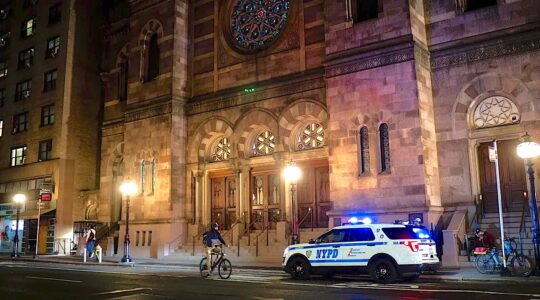Decades ago, when I worked with several Jewish outreach organizations, the emotional highlight of every weekend Shabbaton was the Havdalah ceremony, the termination and climax of the Sabbath. As in summer camp as well, there was the flame from the candles illuminating our faces in a timeless light; there was singing and swaying together arm in arm and inevitably, our moist cheeks reflecting both the joy of what we had experienced together, and the sorrow of losing it.
In the Havdalah blessing, we distinguish between light and darkness. They represent not only the Sabbath and the workweek, respectively, but also, more importantly, the holy and the mundane.
Like a childhood fairy tale implausibly coming to life, for the week following the devastation of Hurricane Sandy, my life embodied the Havdalah.
In the blackout that Sandy begat, on the island of Manhattan, the green line was 39th Street. If you lived on the north side of 39th, life was normal; if you were south, even a yard away, you were imprisoned in the dark ages. In perfect symmetry, I lived two blocks north, but worked two blocks south.
Every morning I crossed Checkpoint Charlie to spend the next 10 hours in darkness. When a high-rise building, like my office, loses power, everything shuts down. There is no light, no heat, no water, no gas, no toilets, no showers, no food refrigeration, no semblance of civilization. The residents gather in the shadows of the dark lobby, like any other survivors of a storm, to commiserate and complain.
Shivering in my candlelit office, trying to reassure and comfort my patients through this heaven-sent crisis, was redolent of two familiar, previous religious experiences. Huddled with candles, without food or water felt like the night of Tisha b’Av, whereas the mood, and the inability to wash or bathe, reminded me of sitting shiva. Perhaps most importantly, in all three instances we mourn our losses.
As a psychiatrist, speaking metaphorically, my job is to help my clients cope with the darkness. Whether transient or long lasting, whether caused by internal or external forces, depression is one of the most devastating and unyielding diseases that any physician ever encounters.
A common putdown of psychiatrists is that we’re sicker than our patients, and that we entered the field to cure ourselves. Sad to say, in some cases it’s probably true.
It was definitely true that my days in darkness were depressing me. Whereas I normally look forward to coming to my office, during the days of darkness, I was counting down the hours until I could leave.
The first two blocks home were bleak; the streets were desolate and silent. Pedestrians were shining flashlights at their feet to avoid tripping. No one made eye contact. No one exchanged greetings or even spoke.
Crossing 39th Street was re-entering the world of living. Music emanated from the open doorways of the bustling bars. Satiated diners filled with good food and good cheer exited overcrowded restaurants. Strangers kibitzed and flirted with each other. It was Joseph’s dream compressed into four blocks, instead of 14 years.
When I walked into my home, night turned into day. If my office felt like Tisha b’Av and shiva, my home felt like Shabbat and Yom Tov every night of the week. I marveled at the transformation, and the immediate improvement in my mood.
Support the New York Jewish Week
Our nonprofit newsroom depends on readers like you. Make a donation now to support independent Jewish journalism in New York.
Was it just the light? There is, after all, a malady we treat called Seasonal Affective Disorder, wherein people become depressed in early winter because of decreased sunlight. One of the treatments for it is, in fact, phototherapy, the systematic application of bright lights.
I didn’t realize the true critical ingredient until, appropriately enough, Friday night. Singing and swaying together with my wife and children as we welcomed the Sabbath bride, looking at their faces illuminated by the timeless light, I finally understood what really distinguished between light and darkness.
Our grown children had moved out and were living together in their own apartments. Since, however, it was below 39th Street, they had moved back in with us for the week of the blackout.
What makes Shabbat the Sabbath is not the day of the week, or the prayers we recite. Whether at a Shabbaton or in your own home, what makes it transcendent is the people with whom you celebrate. What rejuvenated me every night was not the light or the heat in our apartment; it was the joy and the warmth of being embraced by my family in our home.
Six days a week, we work at the pragmatic, necessary task of building our careers. On the seventh day, we rest from the mundane, but work on the sublime — building our families. That is precisely what makes our Sabbaths and our Holy Days holy.
It took a blackout to help me see the light.
Isaac Steven Herschkopf, a local psychiatrist, is a frequent contributor to The Jewish Week.
The New York Jewish Week brings you the stories behind the headlines, keeping you connected to Jewish life in New York. Help sustain the reporting you trust by donating today.




